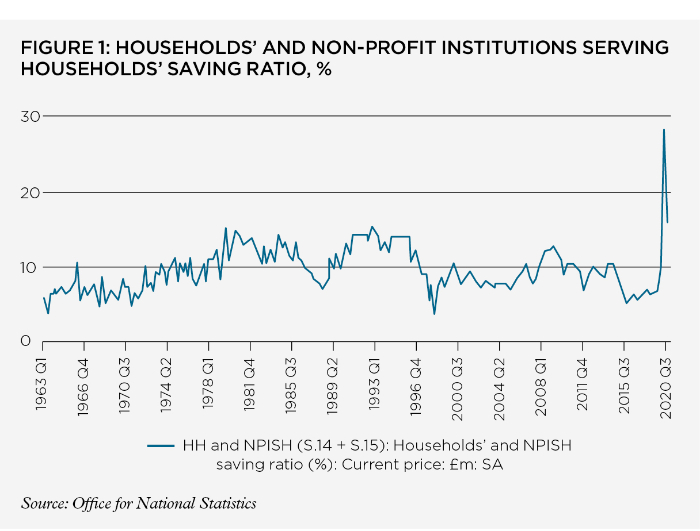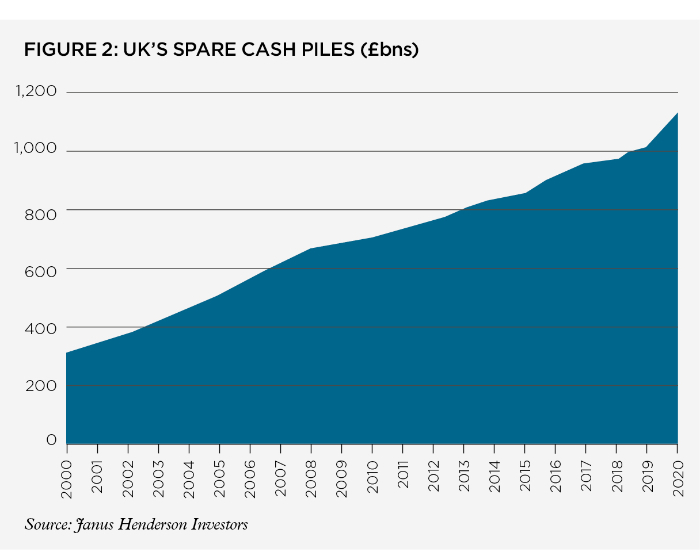The figures provided in this article present an overview of global savings statistics since the onset of the pandemic. As such, they do not show the huge gap between those with extra savings and those who are unemployed or on furlough. Views expressed in this article are those of the author alone and do not necessarily represent the views of the CISI.
Before the Covid-19 pandemic began dominating headlines, the level of household savings in the UK was seen by many in the financial and political worlds as a cause for concern. According to a December 2019 survey of 2,000 UK adults by savings specialists Raisin UK, the average amount of savings held by individuals pre-pandemic was £9,633.30. But this figure disguises enormous disparities within the population. Some 26% of those polled – including 51% of 18–24-year-olds and 18% of over-55s – had less than £1,000 in savings, and 6.5% had no savings at all.
Data from the UK’s Office for National Statistics (ONS), meanwhile, shows that the saving ratio – expressed as the percentage of disposable income that households save – was consistently at its lowest level since the 1970s between Q4 2016 and Q4 2019, hovering between 5.5% and 7.4%.
Then Covid-19 arrived. In the second quarter of 2020, effectively the first three months of lockdown, the saving ratio spiked at 26.5%, almost twice the previous highest figure since the data was first recorded in 1963. As the economy went into freefall, the amount of money that UK households were saving soared to unprecedented levels.

This isn’t just a UK phenomenon. In the US, the Federal Reserve’s personal saving rate – a broadly equivalent measure – shot up from under 10% in February 2020 to 33.7% in April. In the 27 countries of the EU, where the progress of the virus has differed from country to country, the second quarter of 2020 saw the household savings rate increase to a record 23.9%. And in India, household savings climbed to 21.4% of gross domestic product in the June quarter (April to June) 2020 from 7.9% in the previous year, according to preliminary estimates in the Reserve Bank of India’s November 2020 Bulletin.
Part of the explanation is simple. Consumers in lockdown, wherever they are, have little opportunity to spend money on many of the things that they are accustomed to spending it on. Fashion sales in the UK, for example, fell by 40% during the 12 weeks to the end of June 2020, according to research by data and insights consulting firm Kantar.
Less clear is the extent to which the shift to stockpiling cash was motivated by precautionary saving – thrift driven by consumers’ uncertainty about their future incomes. Alistair McQueen, head of savings and retirement at Aviva, says that the initial shock – the inability to spend money – “has since matured into more deep-rooted precautionary saving”. He notes that involuntary saving in the UK – for example, forced saving due to shop closures and reduced travel – ended in Q3 2020 after the first lockdown, with overall November retail sales remaining above pre-pandemic levels, and online November retail growing by 74.7% year-on-year, according to the ONS. Despite the increase in retail spending, the savings ratio remains heightened, as Figure 1 demonstrates. Alistair also cites Bank of England (BoE) data that shows that levels of consumer debt have reduced significantly. He believes that these factors combined indicate “a greater level of precautionary saving”.
The contribution of precautionary saving and its likely persistence at higher levels appears to be borne out by research conducted by the Institute for Fiscal Studies (IFS). During July 2020, when the UK emerged from its nationwide initial lockdown and spending constraints had been lifted, the fourth wave of the Understanding Society’s Covid-19 survey asked householders a hypothetical question: if they were given £500 would they spend it or save it? The results of the research were analysed in the IFS’s MPCs through Covid: spending, saving and private transfers working paper. “Well over 80% [out of the sample size of 10,975 people that the IFS analysed] said they would save it,” says David Sturrock, a senior research economist at the IFS. “What we took away from this is that quite a bit of impetus to save is still there.” The saving ratio, in other words, is expected to stay above its recent historic level for some time to come as the pandemic progresses.
Is saving a positive or a negative?
An increased level of saving sounds, on the face of it, a good thing. Laith Khalaf, a financial analyst at stockbroker AJ Bell, sees it as a “temporary blip” and says: “This is nowhere near enough to address chronic levels of under-saving in the UK. Pensions automatic enrolment in 2012 provided a longer-term solution, but it’s really the very bare minimum of what people need to save for retirement.”
But the downside of increased saving is expressed by Capital Economics economist Thomas Pugh in his UK Economics Update on 10 June. He points out that “households will be less willing to spend in the future”, forecasting that “household spending probably won’t reach its pre-crisis level until 2023”. This trend, according to Pugh, is likely to “weigh on consumption” and prolong the recovery.
The accumulation of savings seen over the past few months has been skewed towards middle-income and high-income households
For Alistair this reflects the UK economy’s excessive reliance on consumer spending. According to the BoE, household spending accounts for about two-thirds of GDP. “Any shock to spending brings with it a shock to the UK economy, as we have witnessed through lockdown”, Alistair says. “But over the longer term, an economy that saves more and invests more should be better placed to thrive in the future.”
The relationship between savings and economic success is complicated, and something that economists continue to debate. It becomes even more contentious when the savings are held in the form of bank deposits or other cash products, rather than as investments in productive enterprises. The evidence from the early stages of the pandemic certainly shows that most of the increase in household savings went into cash. BoE data reveals that banks’ cash monthly deposits in 2020 from the household sector soared from £5.80bn in February to a peak of £26.65bn in May, before falling to to £6.95bn in September. July 2020 research by Aegon into the savings behaviour of consumers during the pandemic shows that 12% of individuals have set up new savings products since the beginning of the crisis, 70% of which are cash-based.
Time to rethink savings?
So, are consumers keeping too much of their savings in cash? Some would argue that it depends on what the money is for. Laith says: “If you need access to the money within five years then cash is really the best place for you. With interest rates on the floor, it means you’re not getting much bang for your buck, however.”
This point is taken up more assertively by James de Sausmarez, director and head of investment trusts at Janus Henderson Investors, who shared its recent research with The Review, showing that UK households have amassed a record £1.5tn savings in cash, with almost £1.2tn of cash savings that are not needed to meet household contingencies, and sitting unproductively earning minimal interest. By saving all this cash, households have missed out on some £38bn of income that would have been earned in the 12-month period from September 2019 to September 2020 if the same amount had been held in equities.

James says: “Our contention is that people are not saving too much in aggregate but that they are saving too much cash in bank accounts where it is working hard for the banks and not them. If their investment horizons are medium to long term (minimum three years) then investing in an equity-based investment product, such as an investment trust, will not only deliver a better income return but the prospect of capital growth as well.”
In terms of the role of the cash savings stockpile in the wider economy, it is mainly useful to the extent that consumers are willing to spend it.
All this raises the question of whether the pandemic should give us pause to rethink what savings are for, and even to come up with new products that can assuage people’s need for security at the same time as directly supporting the recovery and other broader social objectives, such as the UK government’s ‘levelling up’ agenda. It will not have been lost on the UK government that a BoE survey, published in November, reveals that the accumulation of savings seen over the past few months has been skewed towards middle-income and high-income households.
In some jurisdictions, including the EU, there has already been issue of Covid-bonds (although these are aimed mainly at institutional investors), and the UK government has committed to issuing a ‘Green+ Gilt’ sovereign bond in 2021 that will focus funding on a responsible recovery. There is also a growing cohort of environmental, social and governance investment products that might meet this need to some extent. David points out that any product that lends directly to companies appears to be at odds with the criterion of being low-risk.
Laith, meanwhile, says that cash saving is moving forward with the advent of savings hubs – such as the one that AJ Bell has launched recently – which allow savers to choose from a range of cash products from different banks and switch within the portal. At Aviva, however, Alistair McQueen gives an emphatic “no” to the question of whether more products are needed. “The UK financial services sector is one of the most mature in the world,” he says. “Few other countries can match the range of products presented in the UK. So, the priority is not to develop even more products, but to enhance the public’s understanding and engagement with these products.” Empowering customers with digital technology should be a priority for the savings sector, he says: “The company that can educate its clients and empower them with digital technology is set for a bright future.”
The full article was originally published in the February 2021 flipbook edition of The Review.
The full flipbook edition is now available online for all members.